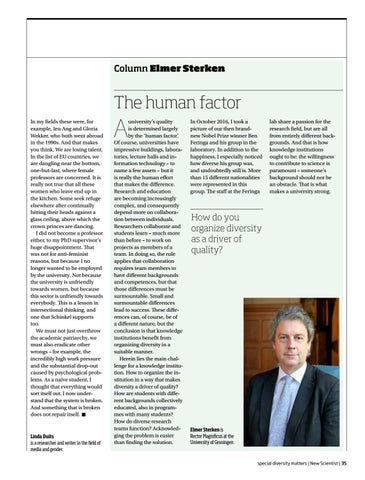Column Elmer Sterken
The human factor In my fields these were, for example, Ien Ang and Gloria Wekker, who both went abroad in the 1990s. And that makes you think. We are losing talent. In the list of EU countries, we are dangling near the bottom, one-but-last, where female professors are concerned. It is really not true that all these women who leave end up in the kitchen. Some seek refuge elsewhere after continually hitting their heads against a glass ceiling, above which the crown princes are dancing. I did not become a professor either, to my PhD supervisor’s huge disappointment. That was not for anti-feminist reasons, but because I no longer wanted to be employed by the university. Not because the university is unfriendly towards women, but because this sector is unfriendly towards everybody. This is a lesson in intersectional thinking, and one that Schinkel supports too. We must not just overthrow the academic patriarchy, we must also eradicate other wrongs – for example, the incredibly high work pressure and the substantial drop-out caused by psychological problems. As a naive student, I thought that everything would sort itself out. I now understand that the system is broken. And something that is broken does not repair itself.
Linda Duits is a researcher and writer in the field of media and gender.
A
university’s quality is determined largely by the ‘human factor’. Of course, universities have impressive buildings, laboratories, lecture halls and information technology – to name a few assets – but it is really the human effort that makes the difference. Research and education are becoming increasingly complex, and consequently depend more on collaboration between individuals. Researchers collaborate and students learn – much more than before – to work on projects as members of a team. In doing so, the rule applies that collaboration requires team members to have different backgrounds and competences, but that those differences must be surmountable. Small and surmountable differences lead to success. These differences can, of course, be of a different nature, but the conclusion is that knowledge institutions benefit from organizing diversity in a suitable manner. Herein lies the main challenge for a knowledge institution. How to organize the institution in a way that makes diversity a driver of quality? How are students with different backgrounds collectively educated, also in programmes with many students? How do diverse research teams function? Acknowledging the problem is easier than finding the solution.
In October 2016, I took a picture of our then brandnew Nobel Prize winner Ben Feringa and his group in the laboratory. In addition to the happiness, I especially noticed how diverse his group was, and undoubtedly still is. More than 15 different nationalities were represented in this group. The staff at the Feringa
lab share a passion for the research field, but are all from entirely different backgrounds. And that is how knowledge institutions ought to be: the willingness to contribute to science is paramount – someone’s background should not be an obstacle. That is what makes a university strong.
How do you organize diversity as a driver of quality?
Elmer Sterken is Rector Magnificus at the University of Groningen
special diversity matters | New Scientist | 35












